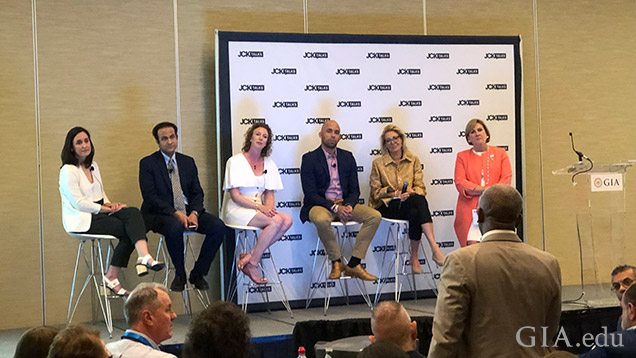GIA JCK 2019 Panel: Consumers Care Where Their Jewelry Comes From
June 14, 2019

Today’s consumers want more than the 4Cs and good design from their jewelry. They also demand that its components – gemstones, diamonds and precious metals – are responsibly sourced.
That was the key message from the GIA panel “Embracing Sustainability Amid New Consumer Expectations,” held at the 2019 JCK Las Vegas show.
The panelists, representing different aspects of the industry, agreed that jewelry companies have to assume responsibility for their products all the way through the value chain.
Moderator Susan Jacques, GIA president and CEO, began the discussion with a brief video about the evolution of public perception of the industry. The video showed images of artisanal gem and gold miners coupled with negative headlines, which segued into news about industry efforts to address the issues. She commented that, despite significant efforts, including the Kimberley Process and the establishment of the Responsible Jewellery Council (RJC), this is what consumers have heard for years about the industry.
“There are so many positive stories to be told, with organizations like the Diamond Development Initiative and Responsible Jewelry Council,” she said. “Now the industry must work hard to change these perceptions.”
The five panelists - Dr. Saleem Ali, University of Delaware; Marcus ter Haar, CEO of Okavango Diamond Company, Botswana; Lisa Bridge, CEO of Ben Bridge Jewelers; Nadja Swarovski, member of the Swarovski Executive Board; and Claire Piroddi, sustainability manager for watches and jewelry at French luxury group Kering - detailed the efforts their organizations to do just that.
Ali, a professor of energy and environment, said that jewelry may be a luxury product that not everyone needs, but it does sustain a standard of living for many people who work in the gem and jewelry supply chain.
“These workers can create wealth and economic growth from the elements of the Earth,” he said, adding that conditions must be there to enable them to do so.
Ter Haar cited the benefits diamonds have brought to Botswana.
“It’s the circles of sustainability: people, planet, profit,” he said. “In Botswana, we’ve seen our capital grow from a small town to a progressive, modern city, [with] a great increase in life expectancy, free health care – all from diamonds, which account for 50% of government revenue and 30% of GNP. Every diamond purchased represents food on the table.”
Swarovski told the audience that, today, companies must think of others as well as themselves. Her company focuses on three basic principles: positive production, women’s empowerment and fair partnerships.
“Our company embraces the United Nations’ 17 sustainable development goals,” she told the audience, outlining initiatives the company was making to implement the UN goals in Swarovski’s operations and with sourcing partners worldwide. These include gender equality, clean water and sanitation, clean energy and reduced carbon footprint, responsible sourcing, equitable work standards and responsible consumption.
Piroddi said that Kering, which includes such jewelry and watch brands as Pomellato and Boucheron, has developed a sustainability road map to 2025 built on three pillars:
- Care – designed to reduce the company’s environmental footprint and work toward 100% vetted sources in its supply chain
- Collaborate - promote gender equality and to be an employer of choice
- Create – embrace new technologies and innovation, and encouraging start-ups
She pointed out that “95% of luxury products come from nature, so we must take care of our environment.” She also said that in a company survey done for its fashion brands, “75% of people care where their products come from – they are more informed than ever.”
Lisa Bridge told the audience that “sustainability begins at home” and noted that the company supports community organizations in each town where it has stores.
“We encourage our employees to give back to their communities as well,” she said.
Further afield, Bridge staff personally visit each of its vendors so it can stand by its products “and we can be certain our jewelry is what we say it is.”
Russell Shor is senior industry analyst at GIA in Carlsbad.



